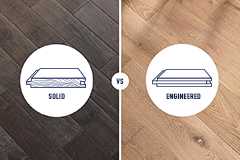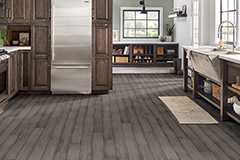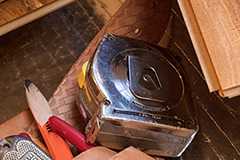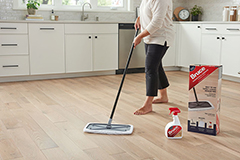How to Match Hardwood Floors
May 1, 2024 | By Bruce Product Expert
As the new homeowner, they want to extend the hardwood flooring into that living room instead of keeping the carpet. And now, the challenge begins — finding a way to match the wood floors from one room to the next.
Fortunately, you can take on the challenge and succeed, but it may require the help of a professional. If you’re interested in taking the challenge on yourself, though, here are some tips on how to match hardwood floors.
Talk to the Previous Homeowner
Start by talking to the previous homeowner. They might be able to tell you where they bought the current hardwood and who installed it. If you’re lucky, they might uncover the brand and collection so you can find an exact match.
If not, the task gets more challenging but perfectly doable.
Research Your Existing Wood Floors
You must do some homework if you’re serious about matching the existing hardwood as closely as possible. You’ll need to research the hardwood floors in your home to uncover several essential characteristics.
For example, you’ll need to note the kind of wood, its grain patterns, characteristics, and any unique features. In addition, you’ll need to evaluate the finish and color variations.
Does the current flooring have neutral undertones or warm tones, for instance? And while you’re at it, you may want to identify any damage to the existing hardwood. It could be that there are areas that may require repairs or replacement.
So, let’s examine some of these critical concerns more closely.
Identify the Thickness of the Existing Flooring
Start by determining if you’re dealing with solid hardwood or engineered hardwood. You’ll have an easier time matching your flooring by remaining consistent with the flooring style.
Next, determine the thickness of the flooring. Hardwood comes in varying thicknesses, typically 1/2″, 5/8″, and 3/4″. Matching plank thickness lets you lay the new hardwood flush with the existing flooring.
Needless to say, you’ll also have to ensure the subflooring is flush. If not, you must address that issue before tackling the hardwood.
What Species is the Current Wood Flooring?
You’ll need to identify the species and grade of the existing hardwood. Is it maple, oak, hickory, pine, or other species? Each has unique grain characteristics and coloration.
In addition to the wood species, you’ll need to determine the flooring’s grade — clear, select, common, or rustic. Different grades have different quality levels, not to mention wear and longevity considerations.
How Wide Are the Hardwood Planks?
Narrow-width planks, often as narrow as 2-1/4 inches, have been a long-standing favorite with homeowners. So, use a tape measure to establish the plank width. For consistency, you’ll want to retain the current width.
For example, aligning five-inch planks with more narrow planks sends a clear signal you’ve installed different flooring.
Examine the Floor’s Finish
The good news is that unfinished hardwood flooring lets you easily adjust the floor’s color. So if you match the species, thickness, grade, and plank width, you’ve accomplished most of the task.
So, if the current floors are oak and you match that species and grade, the final step is matching the color.
When finishing the floors, you’ll need to match the color and gloss level to complete the match.
Here’s a tip: once you’ve completed all the homework, you can get flooring samples and compare them to the existing hardwood. Pay particular attention to graining and wood tones.The good news is that unfinished hardwood flooring lets you easily adjust the floor’s color. So if you match the species, thickness, grade, and plank width, you’ve accomplished most of the task.
So, if the current floors are oak and you match that species and grade, the final step is matching the color.
Installing the New Hardwood
Acclimate the new hardwood to the environment by allowing it to adjust to the room’s temperature and humidity. Choose the appropriate installation method, such as nail-down, glue-down, or floating, depending on the type of hardwood and subfloor.
Ensure proper spacing and pattern alignment to achieve a seamless look. Secure the new hardwood to the subfloor.
Finishing and Blending
Use the sample wood we mentioned to apply different stain colors with varying intensities and pair them with the existing floor. Keep experimenting until you find as good a match as possible.
Any slight discrepancies in color will be barely noticeable once you add pieces of furniture, area rugs, and accessories. However, if you’re particularly meticulous, you can sand and refinish the entire floor.
Once you’ve established the color, apply the desired finish to the new hardwood. Blend the existing and new hardwood floors by feathering in the stain or finish, ensuring a consistent appearance.
Transitions Between Wood Flooring
Here’s something else worth considering — flooring doesn’t have to match precisely. That’s where transitions are helpful, as they can help you adjust heights. They can also help you change the hardwood direction and even allow you to adjust color from room to room.
Bruce® Leads the Way with Hardwoods
We’ve been an industry leader with hardwood flooring for nearly 150 years. Both contractors and DIY enthusiasts turn to us for their flooring needs.
Find the nearest Bruce® retailer by using our store locator.

Ready to shop for hardwood flooring near you?
Use our retail locator to find where you can buy Bruce oak flooring.
Find a Store

 Solid vs Engineered Hardwood Flooring
Solid vs Engineered Hardwood Flooring Guide To Choosing a Hardwood Floor
Guide To Choosing a Hardwood Floor Hardwood Flooring Room Inspiration Guide
Hardwood Flooring Room Inspiration Guide 10 Things to Know About Hardwood Floor Installation
10 Things to Know About Hardwood Floor Installation How To Clean and Protect Hardwood Flooring
How To Clean and Protect Hardwood Flooring